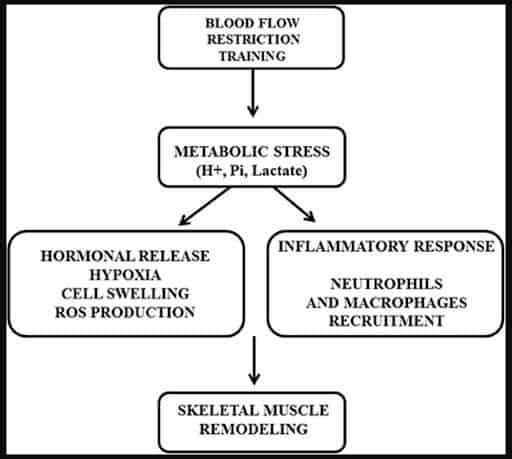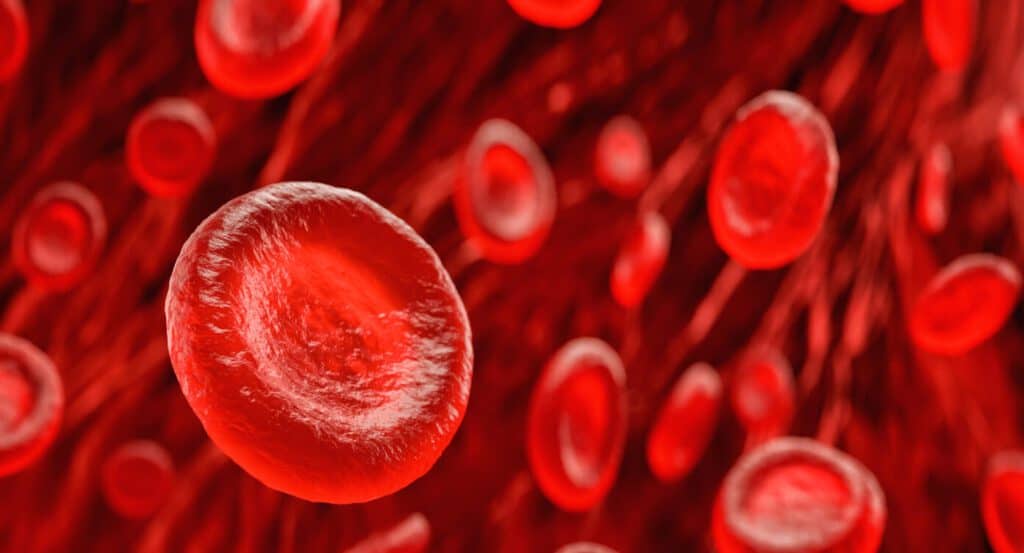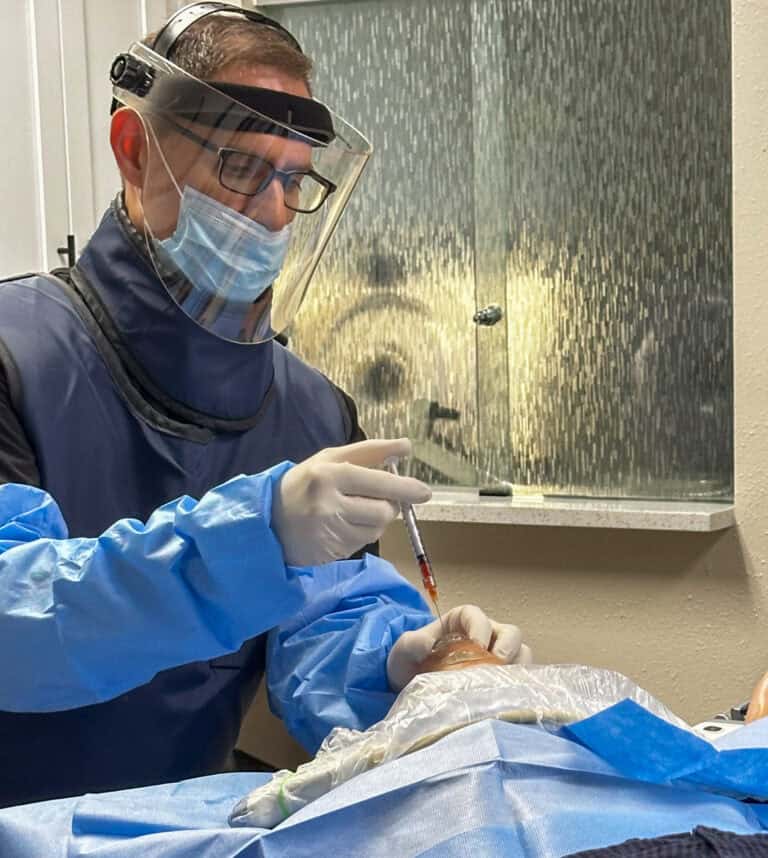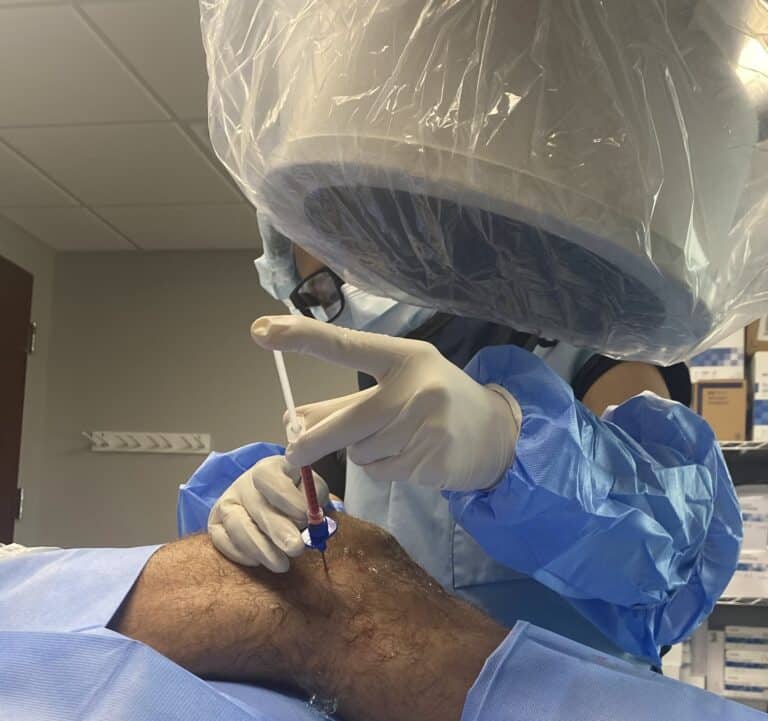Can Blood Flow Restriction (BFR) therapy help you recover better than ever from a Regenexx procedure? Blood flow restriction is a fitness training and rehabilitation technique that has been used across a variety of populations in combination with low-level exercise to help build stronger muscles.
This article is to give an overview of what BFR is, how it works, and why it might be the holy grail for strengthening after a Regenexx procedure.
What is Blood Flow Restriction (BFR)?
Blood Flow Restriction is a muscle training technique that has been used to restrict blood flow during light exercise to stimulate muscle growth.
Specifically, BFR is the act of placing compressive bands on the uppermost portion of a limb (e.g., high up on the arm near the shoulder, or high up on the thigh near the hip). These bands then create compression and restrict blood flow from the veins, causing a short, temporary tourniquet effect in the limb.
While this temporary compression is being applied, the blood flow-restricted area is exercised lightly. Since the tourniquet applies an external stressor, the load used for the exercise is very light. This would be less than 50% of what the person is capable of lifting. So, if the person is capable of squatting 100 pounds one time in a normal setting, the weight used while using BFR would be less than 50 pounds, or even just bodyweight.
Under this light load, several sets of high reps are performed. This is to the tune of 20% load for 5 sets of 20 knee extensions, for example. Then, the compressive apparatus is removed, and voila, muscle growth!
Seems simple enough, but how does this really work? Now, we get to dig into what’s happening at the cellular level.
What are the physiological effects of BFR?
The short explanation of what BFR does physiologically is: it creates an environment of physiologic stress by restricting the rate of blood flow into the limb.
The area that has reduced blood flow then experiences lower than normal oxygen levels. This is a temporary, or transient, ischemia (lack of blood flow and oxygen) that puts the area in a state of functional metabolic stress and a biochemical cascade leading to tissue growth and remodeling in the muscles (Figure 1).

In the biochemical cascade of BFR with low-intensity training, there is a resulting increase in growth hormone and other muscle-building substances. Additionally, the BFR also shows evidence of stimulating myostatin blockers(3), which leads to muscle growth.
When compared to the physiologic effects of high-intensity training or low-intensity training without BFR, low-intensity training with BFR has a greater effect on muscle growth(4). When BFR is utilized, there is a therapeutically beneficial ability to get more muscle cell growth with minimal exercise load(4).
In short, the effects of blood flow restriction allow for muscle growth with less load from weights.
Why could BFR be a good choice for rehabilitation after a Regenexx procedure?
Well, muscle growth means stronger tissues and more supported joints.
So, after a Regenexx procedure, the goal is to rehabilitate the affected joints and tissues. However, the rehabilitation protocols order a conservative, stepwise return to loading the tissue or joint that was treated with Platelet-rich plasma or bone marrow concentrate, meaning there cannot be too much load too soon in these areas. If a patient progresses load or intensity in rehab too quickly, they could risk a flare-up or prolonged inflammation and pain.
For the first six weeks following a procedure, the patient first starts with restoring full range of motion to the joint or tissue treated, followed by local (single joint) strengthening and eventually global (multi-joint) strengthening exercises to support a full recovery. And as aforementioned, it is important to avoid overloading or overstressing the treated area too soon.
BFR therapy is a great strategy to utilize in the early stages of rehabilitation post Regenexx procedure. As mentioned above, the load utilized in BFR therapy is a fraction of the usual load needed to create muscle growth. In the case of BFR, a patient would be able to expose their muscles to a safe strengthening stimulus sooner than waiting for their joint or tissue to be able to tolerate the normal loads needed for muscle growth.
There are several BFR tools, and they vary from compression straps to compression bands (RockFloss), to mechanical compression devices, like Kaatsu.
Different providers may utilize or recommend different tools, so ask your Regenexx physician and rehabilitation therapist if BFR is a good option for your Regenexx procedure recovery. If you’re interested in learning more about Regenexx procedures our Regenexx Procedure Candidate Form is a great place to start understanding if regenerative orthopedic medicine is right for you.
Annotations
- https://centenoschultz.com/physical-therapy/blood-flow-restriction/
- https://www.frontiersin.org/articles/10.3389/fphys.2018.01376/full
- https://www.ncbi.nlm.nih.gov/pmc/articles/PMC4042658/
- https://docs.google.com/document/d/18spauxTyIUP7mdbehehxRfK94MqLDpjy011Y_wm2bQc/edit










